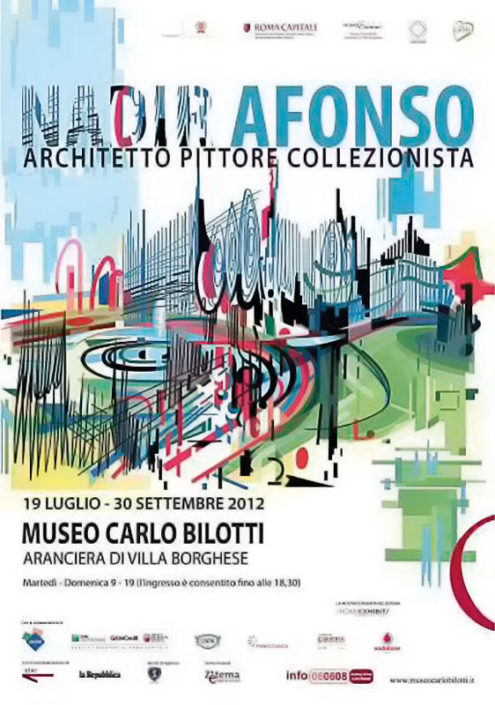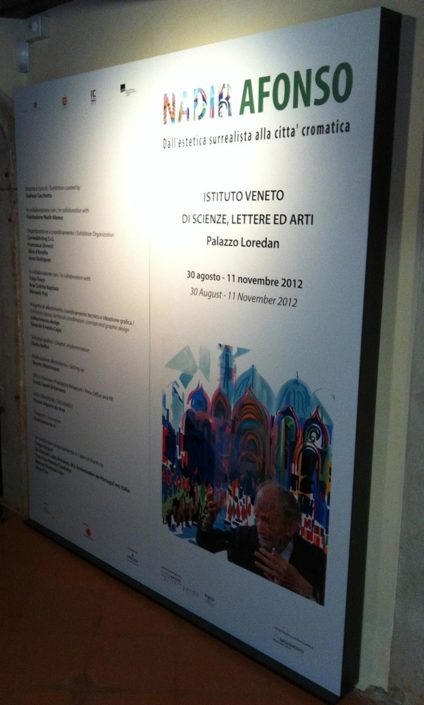NADIR AFONSO
IN ITALY
DESCRIPTION
The exhibition NADIR AFONSO. ARCHITECT, PAINTER AND COLLECTOR curated by Stefano Cecchetto will be held in Rome from July 18 to September 30, 2012 at the Bilotti Museum. The show is on the patronage of the Museu da Presidencia da Republica of Lisbon and the Embassy of Portugal in Rome.
Another show in Italy is in Venice. The exhibition is held at the Institute of Sciences, Letters and Arts Loredan Palace on occasion of the Architecture Biennial exhibition. This show highlight Nadir Afonso’s identity as an architect and artist, and his work in cooperation with two great architects: Le Corbusier and Oscar Niemeyer.
On the other side, in addition to Afonso’s work as a painter, the Roman exhibition was designed to look at his activity as a collector, displaying artworks by his artist friends with whom he was in contact. These include Pablo Picasso, Max Ernst, Candido Portinari, Giorgio de Chirico, Max Jacob, and Fernand Léger.
The show reconstructs the atmosphere of the second half of the 20th century by looking at Nadir Afonso in his status as an artist who was a friend of many other artists. In that period, the interaction between different genres and intellectual discussions were without doubt driving forces for a renewed vigour in art. The works chosen are linked to the Baroque aspects of the city and metaphysical features, in order to illustrate the links with De Chirico who had a notable effect on Afonso’s expressionist work.
The opportunity for learning more about Portuguese artist Nadir Afonso, his work and his cultural milieu, began to take shape two years ago, promoted by the Foundation formed by the artist himself in order to celebrate his ninetieth birthday with a series of international exhibitions. After Paris, Rio de Janeiro and Lisbon, Rome is the location for this tribute to a multi-faceted personality of 20th-century art.
The core of the exhibition was designed principally with the objective of illustrating the artist’s contemporary work. Over the last ten years, works by Afonso transmit the power of innovative motifs that transcend the conventional structures of art movements and explore a new language of form.
Nadir Afonso’s Cities take the form of emergent architecture. They seem to appear from a reality that has been eliminated, but that nonetheless surfaces in the structures of diagonal and straight lines, and sinusoidal waves in different colours, in which the quiet intimacy of the artist’s vision expands in order to search for a new, more extensive and organized space.
The many works from this last phase that are shown in the exhibition include Florença (2006) in which the Tuscan city is immersed in shades of red, and is apparently constructed on hyperbolic curves; Kuala Lumpur (2008), which takes form from a pattern of swirling colour; Toronto (2007), in which the composition’s structure is suspended in space; and Citade Incerta (2010), in which the poetry of gesture seems to be constructed on the perspective of evanescent geometry.
These recent works, more than others, reveal the artist’s power and determination to continue his personal quest for the rediscovery and application of a new metaphysical language.
The exhibition also presents a series of works illustrating Nadir Afonso’s oeuvre, starting from pieces linked to the 1950s-‘60s period, right through to the most recent paintings that are based on the theme of the city and its chromatic interpretation.
The first part of the exhibition presents works most closely linked to the ‘pre-geometric’ and ‘Baroque’ stage of the early 1950s, which developed from Afonso’s practice of architecture. These paintings, often with a very striking visual effect based on the hues used, suggest a ‘Spatialist’ treatment emerging from the interchange of tones and colours, and the artist’s personal pleasure in inventing planes of perspective. But even here, in the process of composition, the artist abandons pure enjoyment, standardized schemes and ephemeral pictorial ideologies, and returns to a preference for renewed commitment. This would lead him towards the expressionism of a completely personal language
STAGES
ITALY. Venice, Palazzo Loredan. August 30 – November 11, 2012
ITALY. Rome, Museo Carlo Bilotti. July 18 – September 30, 2012




